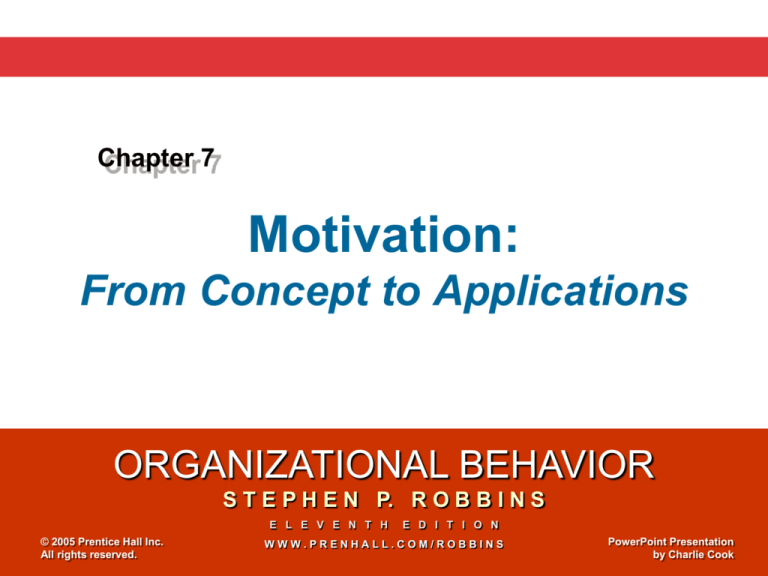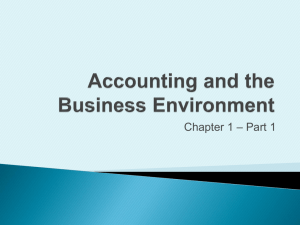
Chapter 7
Motivation:
From Concept to Applications
ORGANIZATIONAL BEHAVIOR
S T E P H E N P. R O B B I N S
E L E V E N T H
© 2005 Prentice Hall Inc.
All rights reserved.
E D I T I O N
WWW.PRENHALL.COM/ROBBINS
PowerPoint Presentation
by Charlie Cook
Performance Dimensions
Source: Adapted from M. Blumberg and C.D. Pringle, “The Missing Opportunity in
Organizational Research: Some Implications for a Theory of Work Performance,” Academy
of Management Review, October 1982, p. 565.
6–1
Contrasting Views of Satisfaction and Dissatisfaction
E X H I B I T 6–3
© 2005 Prentice Hall Inc. All rights reserved.
6–2
Two-Factor Theory (Frederick Herzberg)
Two-Factor (Motivation-Hygiene) Theory
Intrinsic factors are related to job satisfaction,
while extrinsic factors are associated with
dissatisfaction.
Hygiene Factors
Factors—such as company policy
and administration, supervision,
and salary—that, when adequate
in a job, placate workers. When
factors are adequate, people will
not be dissatisfied.
© 2005 Prentice Hall Inc. All rights reserved.
6–3
ERG Theory defined…
Source: Dictionary of Human Resource Management, 2001, p112-112
Chris Alderfer’s ERG theory is based on the assumption that
people have three types of need: Existence, Relatedness, and
Growth:
a) Existence needs are concerned with physiological
factors, which at work are expressed as concern over
remuneration and working conditions.
b) Relatedness needs are concerned with having
meaningful interactions with other people—co-workers,
managers, customers, etc.
c) Growth needs are concerned with personal
development, creativity, and feelings of achievement (see
self-actualization).
© 2005 Prentice Hall Inc. All rights reserved.
6–4
ERG Theory… Key points for managers
• The message for managers is that policies and
practices must be devised to help satisfy these
needs because this will result in fulfilled and
motivated employees.
• Although very similar to Maslow's hierarchy of
needs, ERG theory does not stipulate (mean:
require/insist on/specify) that the needs have to be met in
a particular order.
6–5
David McClelland’s Theory of Needs
An individual’s specific needs are acquired over time and are shaped by one’s life
experience. Most of these needs can be classified as under:
Need for Achievement
Need for Affiliation
The drive to excel, to achieve
in relation to a set of
standards, to strive to
succeed.
The desire for friendly
and close personal
relationships.
Need for Power
The need to make others
behave in a way that they
would not have behaved
otherwise.
© 2005 Prentice Hall Inc. All rights reserved.
nPow
nAch
nAff
6–6
McClelland’s Theory of Needs (cont’d…)
Source: http://www.netmba.com/mgmt/ob/motivation/mcclelland/
7–7
Theory of Needs: Implications for Management
People with different needs are motivated differently.
1.High need for Achievement: High achievers should be given
challenging projects with SMART goals. They should be provided
frequent and instant feedback. While money is not an important
motivator, it is an effective form of feedback.
2.High need for Affiliation: Employees with a high affiliation need
perform best in a cooperative environment.
3.High need for Power: Management should provide power (mean:
ability to influence) seekers the opportunity to manage others
Note:
McClelland’s theory allows for the shaping of a person’s needs;
training programs can be used to modify one’s need profile.
© 2005 Prentice Hall Inc. All rights reserved.
7–8
Matching High Achievers and Jobs
E X H I B I T 6–4
© 2005 Prentice Hall Inc. All rights reserved.
6–9
Cognitive Evaluation Theory
Description
When looking at task, we evaluate it in terms of how well it
meets our needs to feel competent and in control. If we think
we will be able to complete the task, we will be intrinsically
motivated to complete the task, requiring no further external
motivation.
Where a person has a stronger internal locus of control they
will feel they are in control of how they behave.
Where they have a stronger external locus of control, they
will believe the environment or others have a greater
influence over what they do.
© 2005 Prentice Hall Inc. All rights reserved.
6–10
Cognitive Evaluation Theory (cont’d…)
People may see external rewards as achieving some degree of
control over them or may see the reward as informational, such as
where they reinforce feelings of competence and selfdetermination.
When people see the reward as mostly for control they will be
motivated by gaining the reward but not by enacting the requested
behavior.
So what?
When you ask someone to do something, if you want them to be
motivated then ensure that it falls within their current level of
competency.
© 2005 Prentice Hall Inc. All rights reserved.
7–11
The Job Characteristics Model (JCM)
The job characteristics model, designed by
Hackman and Oldham, is based on the idea that
the task itself is key to employee motivation.
Specifically, a boring and monotonous job stifles
motivation to perform well, whereas a
challenging job enhances motivation.
Variety, autonomy and decision authority are
three ways of adding challenge to a job.
Job enrichment and job rotation are the two
ways of adding variety and challenge.
7–12
Hackman and Oldham Job Characteristics Model
Source: J.R. Hackman and G.R. Oldham, Work Design (excerpted from pp. 78–80). © 1980 by Addison-Wesley
Publishing Co., Inc. Reprinted by permission of Addison-Wesley Longman, Inc.
© 2005 Prentice Hall Inc. All rights reserved.
E X H I B I T 6–6
6–13
Hackman and Oldham's Motivating Potential Score of Jobs
Source: Empirically Derived Job Characteristics Measures And The Motivating Potential Score.
By: Lee-Ross, Darren. Journal of Management Development, 1999, Vol. 18 Issue 4, p342
MPS = an index of how likely a job is to affect an employee's attitudes and behaviors
People who work on jobs with high core dimensions are
generally more motivated, satisfied, and productive.
Job dimensions operate through the psychological states in
influencing personal and work outcome variables rather than
influencing them directly.
© 2005 Prentice Hall Inc. All rights reserved.
6–14
John Stacey Adams’s Equity Theory (1963)
Equity Theory
Individuals compare their job inputs and outcomes
with those of others and then respond to eliminate
any inequities.
Adams called personal efforts and
rewards and other similar 'give and
take' issues at work respectively
'inputs' and 'outputs'.
Inputs are logically what we give or put
into our work. Outputs are everything
we take out in return.
Referent
Comparisons:
Self-inside
Self-outside
Other-inside
Other-outside
© 2005 Prentice Hall Inc. All rights reserved.
6–15
Equity Theory (cont’d)
E X H I B I T 6–7
© 2005 Prentice Hall Inc. All rights reserved.
6–16
Compulsory Home Reading Assignment
Employee Motivation: A Powerful New
Model by Nitin Nohria, Boris Groysberg, and Linda-Eling Lee,
Harvard Business Review, 2008
© 2005 Prentice Hall Inc. All rights reserved.
7–17
© 2005 Prentice Hall Inc. All rights reserved.
7–18








